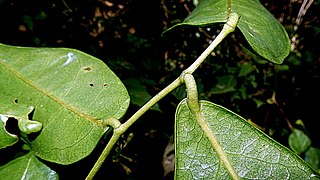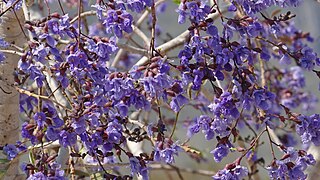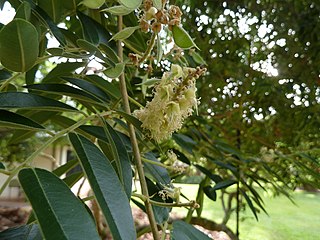
Pterocarpus is a pantropical genus of trees in the family Fabaceae. It belongs to the subfamily Faboideae, and was recently assigned to the informal monophyletic Pterocarpus clade within the Dalbergieae. Most species of Pterocarpus yield valuable timber traded as padauk, usually pronounced or ; other common names are mukwa or narra. The west African species may be traded as African rosewood. P. santalinus also yields the most precious red sandalwood in China known as Zitan. The wood from the narra tree and the Burmese padauk tree is marketed as amboyna when it has grown in the burl form. The scientific name is Latinized Ancient Greek and means "wing fruit", referring to the unusual shape of the seed pods in this genus.

Aotus is an Australian genus of flowering plants, within the legume family Fabaceae. Aotus species, together with other species of the tribe Mirbelieae, are often called golden peas because of their distinctive small yellow flowers. They are endemic to Australia, occurring in all states except the Northern Territory. Aotus are evergreen species. Some are widely cultivated by gardeners for their ornamental value.

Leptosema is a genus of flowering plants from the legume family Fabaceae. According to the Australian Plant Census, species of Leptosema occur in the Northern Territory, Western Australia, South Australia and Queensland.

Diplotropis is a genus of trees. It includes ten species native to northern South America, ranging from Colombia and Venezuela to Bolivia and west-central and southeastern Brazil.

Dipteryx is a genus containing a number of species of large trees and possibly shrubs. It belongs to the "papilionoid" subfamily – Faboideae – of the family Fabaceae. This genus is native to South and Central America and the Caribbean. Formerly, the related genus Taralea was included in Dipteryx.

Templetonia is a genus of flowering plants in the family Fabaceae. They are native to Australia. The genus is named in honour of John Templeton, an Irish naturalist and botanist.

Melolobium is a genus of 15 species of flowering plants belonging to the family Fabaceae. It is native to southern Africa, where it is found in south and east Namibia, southwest Botswana, and most of South Africa.

Ormosia is a genus of legumes. The more than 100 living species, mostly trees or large shrubs, are distributed throughout the tropical regions of the world, some extending into temperate zones, especially in East Asia. A few species are threatened by habitat destruction, while the Hainan ormosia is probably extinct already.

Platymiscium is a genus of flowering plants in the family Fabaceae, and was recently assigned to the informal monophyletic Pterocarpus clade within the Dalbergieae. It has a Neotropical distribution, from northern Mexico to southern Brazil. Platymiscium is the only genus in the family with opposite leaves in all its species. Its wood has various uses, mostly for constructions and furniture. It's wood is also sometimes referred to as Granadillo, Macacauba, Macawood, Hormigo, or Orange Agate.

Poecilanthe is a genus of flowering plants in the family Fabaceae.

Isotropis is a genus of flowering plants in the family Fabaceae. The genus is endemic to Australia.

Piliostigma is a genus of flowering plants in the legume family, Fabaceae. It belongs to the subfamily Cercidoideae and the tribe Bauhinieae. It is dioecious, with male and female flowers on separate plants.

Amicia is a genus of flowering plants in the legume family, Fabaceae. It includes seven species which are native to Mexico, Panama, Ecuador, Peru, Bolivia, and northwestern Argentina. It belongs to the subfamily Faboideae, and was recently assigned to the informal monophyletic Adesmia clade. It is named in honor of the Italian astronomer, mathematician and microscopist Giovanni Battista Amici (1786–1863).

Bowdichia is a genus of flowering plants in the legume family, Fabaceae. It belongs to the subfamily Faboideae. The genus includes two species native to tropical South America and Costa Rica.

Cranocarpus is a genus of flowering plants in the legume family, Fabaceae. It includes three species native to northern and eastern Brazil. It belongs to subfamily Faboideae, and was recently assigned to the informal monophyletic Pterocarpus clade of the Dalbergieae.

Cyathostegia is a genus of flowering plants in the legume family, Fabaceae. It belongs to the subfamily Faboideae. It contains two species native to Peru and Ecuador. It is often considered to be a monotypic genus containing only Cyathostegia mathewsii. Some sources include Cyathostegia weberbaueri.
Fissicalyx fendleri is a species of flowering plant in the legume family, Fabaceae. It is a tree native to the tropical Americas, ranging from Panama through Colombia, Venezuela, and Guyana to northern Brazil. It grows in humid lowland forest.
Latrobea is a genus of flowering plants in the legume family, Fabaceae. It belongs to the subfamily Faboideae. The plant is named after Charles Joseph La Trobe.
Nissolia, the yellowhoods, is a genus of lianas in the legume family, Fabaceae. It includes 32 species native to the tropical and subtropical Americas, ranging from Arizona and Texas through Mexico, Central America, and South America to northern Argentina. It belongs to the subfamily Faboideae, and was recently assigned to the informal monophyletic Adesmia clade of the Dalbergieae.
Bowringia is a genus of flowering plants in the legume family (Fabaceae), found in tropical Africa and southeastern Asia. It includes four species native to western and central Africa and Madagascar, and to Borneo, Indochina, and southern China.















